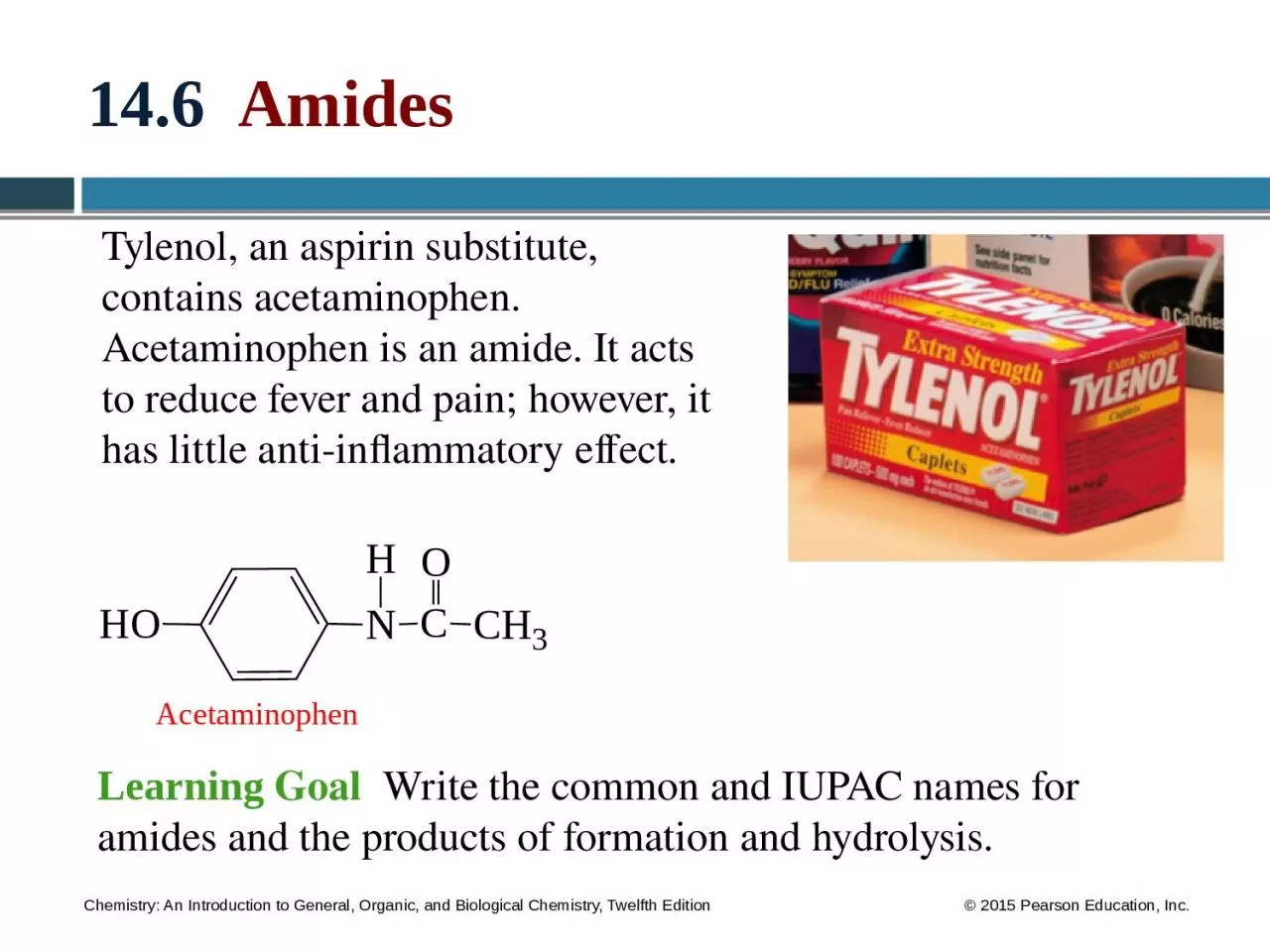

Write the common and IUPAC names for amides and the products of formation and hydrolysis Tylenol an aspirin substitute contains acetaminophen Acetaminophen is an amide It acts to reduce fever and pain however it has little antiinflammatory effect ID: 1006459
Download Presentation The PPT/PDF document "14.6 Amides Learning Goal" is the property of its rightful owner. Permission is granted to download and print the materials on this web site for personal, non-commercial use only, and to display it on your personal computer provided you do not modify the materials and that you retain all copyright notices contained in the materials. By downloading content from our website, you accept the terms of this agreement.
1. 14.6 AmidesLearning Goal Write the common and IUPAC names for amides and the products of formation and hydrolysis.Tylenol, an aspirin substitute, contains acetaminophen. Acetaminophen is an amide. It acts to reduce fever and pain; however, it has little anti-inflammatory effect.
2. AmidesAmides are derivatives of carboxylic acids in which a nitrogen group (—NH2) replaces the hydroxyl (—OH) group of carboxylic acids. Core Chemistry Skill Forming Amides
3. Preparation of Amides: AmidationAmides are produced by reacting a carboxylic acid with ammonia, or a primary or secondary amine, and heat.
4. Study CheckPredict the product of the following amidation reaction:
5. SolutionPredict the product of the following amidation reaction:
6. Naming AmidesIn both the common and IUPAC names, amides are named by dropping the oic acid (IUPAC) or ic acid (common) from the carboxylic acid name and adding the suffix amide.Alkyl groups attached to the nitrogen of an amide are named with the prefix N-, followed by the alkyl name.
7. Guide to Naming Amides
8. Naming AmidesGive the IUPAC and common names for the following amide: SOLUTION: ANALYZE Functional Group Naming the Amide N-Substituent THE amidePROBLEM Replace the oic acid methyl (IUPAC) or ic acid(common) in the carbonyl name with amide.
9. Naming AmidesGive the IUPAC and common names for the following amide:STEP 1 Replace oic acid (IUPAC) or ic acid (common) in the carboxyl name with amide. butanamide
10. Naming AmidesGive the IUPAC and common names for the following amide:STEP 2 Name each substituent on the N atom using the prefix N- and the alkyl name. N-methylbutanamide
11. Study Check Give the IUPAC and common names for the following amides: A. B.
12. SolutionGive the IUPAC and common names for the following amides. A. formamide (IUPAC) ethanamide (common) B. N-ethylpropionamide (IUPAC) N-ethylpropanamide (common)
13. Chemistry Link to Health:Amides and MedicineUrea is the end product of protein metabolismremoved from the blood by the kidneysexcreted in the urineIf the kidneys malfunction, urea is not removed and builds to a toxic level, a condition called uremia.
14. Chemistry Link to Health:Amides and MedicineMany barbiturates are cyclic amides of barbituric acid act as sedatives in small doses or sleep inducers in large dosesare habit formingBarbiturate drugs include phenobarbital (Luminal) and pentobarbital (Nembutal).
15. Chemistry Link to Health:Amides and MedicineAspirin substitutes contain phenacetin or acetaminophenact to reduce fever and pain but have little anti-inflammatory effect
16. Hydrolysis of AmidesAmides undergoacid hydrolysis to produce a carboxylic acid and an ammonium saltbase hydrolysis with heat to produce the salt of a carboxylic acid and an amine or ammonia
17. Base Hydrolysis of AmidesDraw the condensed structural formulas for the products from the hydrolysis of N-methylpentanamide with NaOH.SOLUTION:ANALYZE Reaction Type Reactants ProductsTHE base hydrolysis PROBLEM N-methylpentanamideNaOHsodium pentanoatemethylamine
18. Base Hydrolysis of AmidesDraw the condensed structural formulas for the products from the hydrolysis of N-methylpentanamide with NaOH.In the base hydrolysis of the amide, the amide bond is broken between the carboxyl carbon atom and the nitrogen atom the products are the carboxylate salt and an amine
19. Study CheckDraw the structures of the following:A. pentanamideB. N-ethylbenzamide
20. Solution Draw the structures of the following:A. pentanamide B. N-ethylbenzamide
21. Carboxylic Acids, Esters, Amines, and Amides—Concept Map